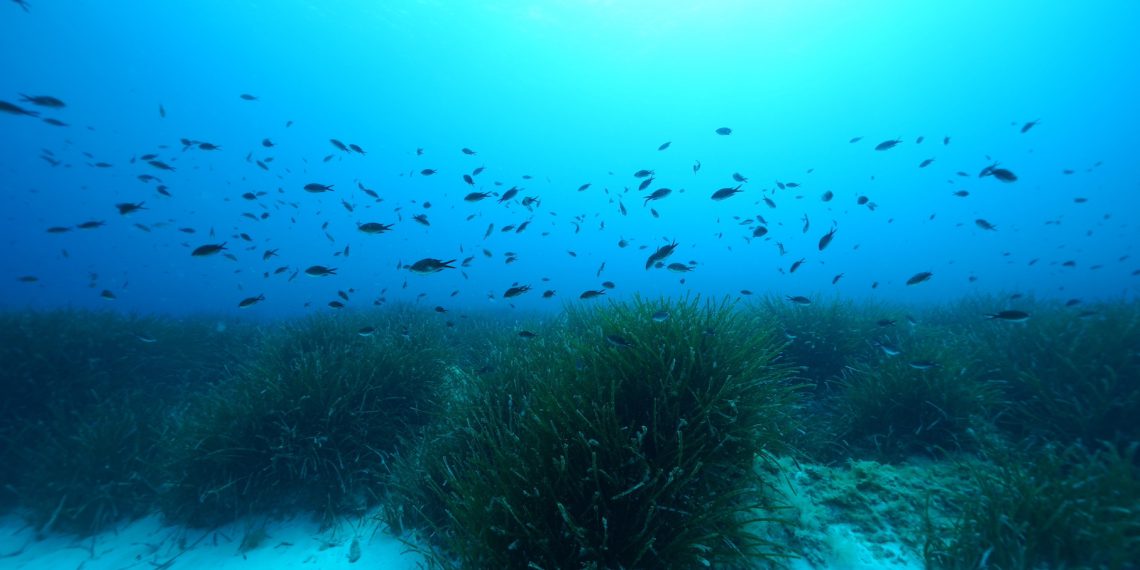Large quantities of sugar are released into the soil by seaweeds. Worldwide, that’s more than 1 million metric tons of sucrose — enough sugar for 32 billion cans of cola. This is astonishing: Normally, microbes consume any freely available sugar in a flash. Researchers at the Max Planck Institute for Marine Microbiology also found that the seaweeds release phenols. These keep most microbes from breaking down sucrose. Thus, it is possible that it remains buried under the seagrasses and is not converted into CO2 and released back into the ocean and atmosphere. The researchers now present their discovery in the journal Nature Ecology & Evolution.
Seagrasses form lush underwater meadows in many coastal regions of the world. These marine plants are very efficient at removing carbon dioxide from the atmosphere: one square kilometer of seagrass stores almost twice as much carbon as forests on land, and 35 times as fast. Now, researchers at the Max Planck Institute for Marine Microbiology in Bremen, Germany, have found that seagrasses release a lot of sugar into their soils, called the rhizosphere. The concentration of sugar under the seagrass was at least 80 times higher than anything previously measured in the ocean. “To put this in perspective, we estimate that between 0.6 and 1.3 million tons of sugar, mainly in the form of sucrose, are stored in the seagrass rhizosphere worldwide,” explains Manuel Liebeke, head of the Metabolic Interactions research group at the Max Planck Institute for Marine Microbiology. “That’s roughly equivalent to the amount of sugar in 32 billion cans of Coke!”
Phenols spoil microbes’ sweet tooth
Microbes love sugar: it’s easy to digest and full of energy. Why don’t the numerous microorganisms in the seagrass rhizosphere snack on sucrose? “We’ve been trying to figure that out for a long time,” says first author Maggie Sogin, who led the research off the Italian island of Elba and at the Max Planck Institute in Bremen, Germany, and is now at the University of California Merced. “We found that seagrass — like many other plants — releases phenols into its sediment.” Phenols are not uncommon in our environment: red wine, coffee and fruit are full of them, and many people take them as dietary supplements. But these substances also have antimicrobial effects and inhibit the metabolism of most microorganisms. “We did experiments where we exposed the microorganisms in the seagrass rhizosphere to phenolics isolated from the seagrass — and sure enough, much less sucrose was consumed there than when we didn’t add phenolics.”
Some specialists use the sugars under the seagrass
“The seagrass produces the sugars during photosynthesis. Under average light conditions, the plants use most of this sugar for their own metabolism and growth. But in very strong light, for example at midday or in summer, they produce more sugar than they can use or store. Then they release the excess sucrose into their rhizosphere. It’s sort of an overflow valve.”
- Nicole Dubilier, director at the Max Planck Institute for Marine Microbiology
Amazingly, a small group of microbial specialists thrive despite the difficult conditions. Sogin suspects that these specialists are not only able to digest sucrose and break down phenols, but also benefit the seagrass — by producing nutrients it needs to grow, such as nitrogen. “We know such beneficial relationships between plants and microorganisms in the rhizosphere well from land plants. But we are just beginning to understand the intimate and complicated interactions of seagrasses with microorganisms in the marine rhizosphere,” Sogin said.
Important endangered habitats
Seagrass beds are among the most threatened habitats on the planet. “Large amounts of stored carbon would be released if seagrass beds continue to decline. Yet our research shows quite clearly that it is not only the seagrass itself that needs to be considered, but also the large amounts of sucrose among the living seagrass meadows. Our calculations show that if the sucrose in the seagrass rhizosphere were broken down by microbes, up to 1,540,000 tons of carbon dioxide would be released into the atmosphere worldwide,” Liebeke explains.
“That’s roughly equivalent to the amount of carbon dioxide emitted by 330,000 cars in a year.” Seagrass populations are declining rapidly in all oceans. Annual losses are estimated to be as high as seven percent in some locations, comparable to the loss of coral reefs and tropical rainforests. As much as one-third of the world’s seagrass may already have been lost. “We don’t know as much about seagrasses as we do about terrestrial habitats,” Sogin points out. “Our study helps us better understand one of the planet’s most important coastal habitats and highlights the importance of conserving these ‘blue carbon ecosystems.’ ”

















